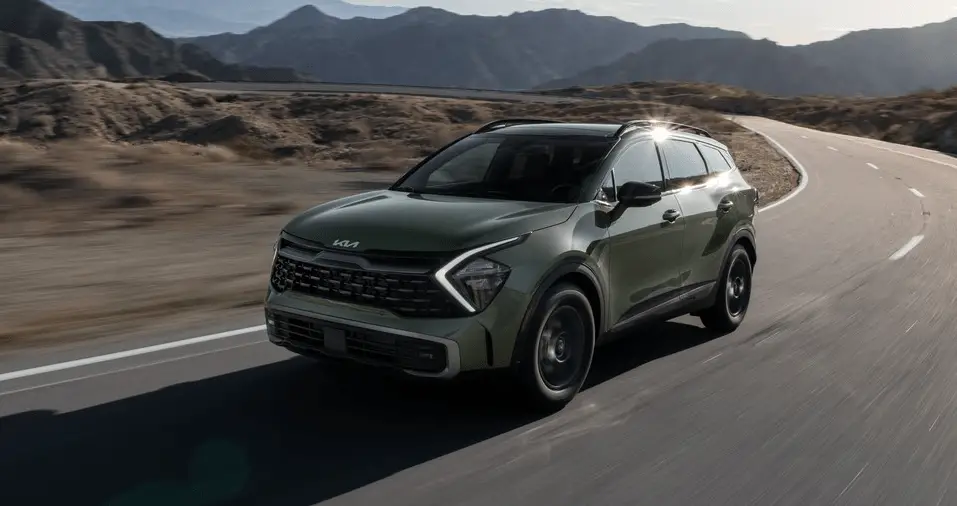 Kia Sportage 2023 Child Restraint and Air Bag – Advanced Supplemental Restraint System
Kia Sportage 2023 Child Restraint and Air Bag – Advanced Supplemental Restraint System
When it comes to car safety, the 2023 Kia Sportage stands out as a model of protection, with the safety of all riders, from the youngest to the oldest, being the top priority. With a strong dedication to protecting lives, this exceptional SUV acts as a watchful parent to its passengers, carefully designed to handle a wide range of child restraint systems, making sure that every trip is safe and follows all safety rules. Inside the Sportage’s protective cocoon is an airbag restraint system that is ready to fire with pinpoint accuracy in the event of a crash, surrounding the people inside in a cushioned shield of safety. As we begin this in-depth look, we’ll reveal the complicated landscape of the 2023 Kia Sportage’s child restraint and airbag restraint systems. This will shed light on important factors and guidelines that allow passengers to travel with confidence, peace of mind, and the assurance of unwavering safety.
2023 KIA SPORTAGE Specs, Price, Features and Mileage (Brochure)
Child Restraint System (CRS)
Infants and younger children must be restrained in an appropriate rear-facing or forward-facing Child Restraint System (CRS) that has first been properly secured to the rear seat of the vehicle.
Infants and younger children must be restrained in an appropriate rear-facing or forward-facing Child Restraint System (CRS) that has first been properly secured to the rear seat of the vehicle Please refer to your state or federal laws for child seating requirements in the operation of a motor vehicle.
Children are always in the rear
Children under age 13 must always ride in the rear seats and must always be properly restrained to minimize the risk of injury in an accident, sudden stop or sudden maneuver.
WARNING
Restraint Location
Never install a child or infant seat on the front passenger’s seat. A child riding in the front passenger seat can be force-fully struck by an inflating airbag and get seriously injured.
WARNING
Hot Child Restraint
A Child Restraint System can become very hot if it is left in a closed vehicle on a sunny day. Be sure to check the seat cover, buckles and latches before placing a child in the restraint system.
According to accident statistics, children are safer when properly restrained in the rear seats than in the front seat. Even with air bags, children can be seriously injured or killed. Children too large for a child restraint must use the seat belts provided.
All 50 states have child restraint laws which require children to travel in approved child restraint devices. The laws governing the age or height/weight restrictions at which seat belts can be used instead of child restraints differs among states, so you should be aware of the specific requirements in your state, and where you are travelling.
The CRS must be properly placed and installed in the rear seat. You must use a commercially available CRS that meets the requirements of the Federal Motor Vehicle Safety Standards (FMVSS).
A CRS is generally designed to be secured in a vehicle seat by lap belt portion of a lap/shoulder belt, or by a LATCH system in the rear seats of the vehicle.
Child Restraint System (CRS)
Infants and younger children must be restrained in an appropriate rear-facing or forward-facing CRS that has first been properly secured to the rear seat of the vehicle. Read and comply with the instructions for installation and use provided by the manufacturer of the CRS.
Child Restraint Installation
An improperly secured child restraint can increase the risk of serious injury or death in an accident. Always take the following precautions when using a Child Restraint System:
- Always follow the Child Restraint System manufacturer’s instructions for
installation and use. - Always properly restrain your child in the child restraint.
- If the vehicle head restraint prevents proper installation of a child seat (as described in the Child Restraint System manual), the head restraint of the respective seating position shall be readjusted or entirely removed.
- Do not use an infant carrier or a child safety seat that “hooks” over a seat-back as it may not provide adequate protection in an accident.
- A child restraint in the centre seating position may also contact or push up against the safety belt buckles, which can damage the buckles and make them unusable or unsafe. Always check that the child restraint does not contact any of the safety belt buckles. Check the placement of the child restraint regularly to make sure that it has not shifted and come into contact with any of the safety belt buckles.
NOTICE
After an accident, have a Kia dealer check the Child Restraint System, seat belts, tether anchors and lower anchors.
Selecting a CRS
When selecting a CRS for your child, always:
- Make sure the CRS has a label certifying that it meets applicable Federal Motor Vehicle Safety Standards (FMVSS 213).
- Select a child restraint based on your child’s height and weight. The required label or the instructions for use typically provide this information.
- Select a child restraint that fits the vehicle seating position where it will be used.
- Read and comply with the warnings and instructions for installation and
use provided with the CRS. - The American Academy of Pediatrics provides helpful fit and safety information about child restraints at www.healthychildren.org
WARNING
Holding children
Never hold a child in your arms or lap when riding in a vehicle. The violent forces created during a crash will tear the child from your arms and throw the child against the car’s interior. Always use a Child Restraint System which is appropriate for your child’s height and weight.
WARNING
Unattended children
Never leave children unattended in a vehicle. The car can heat up very quickly, resulting in injuries to the child in the vehicle.
WARNING
Seat belt use
Do not use one seat belt for two occupants at the same time. This will eliminate any safety benefits provided by the seat belt to the occupants.
CRS types
There are three main types of CRS: rear-facing seats, forward-facing seats, and booster seats. They are classified according to the child’s age, height and weight.
Rear-facing child seats
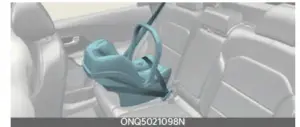
A rear-facing child seat provides restraint with the seating surface against the back of the child. The harness system holds the child in place, and in an accident, acts to keep the child positioned in the seat and reduces the stress to the neck and spinal cord.
All children under age one must always ride in a rear-facing infant child restraint.
Convertible and 3-in-1 child seats typically have higher height and weight limits for the rear-facing position, allowing you to keep your child rear-facing for a longer period of time.
Continue to use a rear-facing child seat for as long as your child will fit within the height and weight limits allowed by the child seat manufacturer. It’s the best way to keep them safe. Once your child has outgrown the rear-facing child restraint, your child is ready for a forward-facing child restraint with a harness.
Forward-facing child restraints
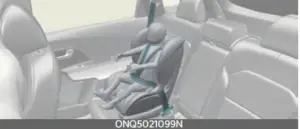
A forward-facing child seat provides restraint for the child’s body with a harness. Keep children in a forward-facing child seat with a harness until they reach the top height or weight limit allowed by your child restraint manufacturer.
Once your child outgrows the forward-facing child restraint, your child is ready for a booster seat.
Booster seats
A booster seat is a restraint designed to improve the fit of the vehicle’s seat belt system. A booster seat positions the seat belt so that it fits properly over the lap of your child.
Keep your child in a booster seat until they are big enough to sit in the seat without a booster and still have the seat belt fit properly. For a seat belt to fit properly, the lap belt must lie snugly across the upper thighs, not the stomach. The shoulder belt should lie snug across the shoulder and chest and not across the neck or face. Children under the age 13 must always ride in the rear seats and must always be properly restrained to minimize the risk of injury.
Installing a CRS
After selecting a proper child seat for your child, check to make sure it fits properly in your vehicle.
Follow the instructions provided by the manufacturer when installing the child seat. Note these general steps when installing the seat to your vehicle:
- Properly secure the child restraint to the vehicle. All child restraints must be secured to the vehicle with the lap part of a lap/shoulder belt or with the LATCH system.
- Make sure the child restraint is firmly secured. After installing a child restraint to the vehicle, push and pull the seat forward and from side to side to verify that it is securely attached to the seat. A child restraint secured with a seat belt should be installed as firmly as possible. However, some side-to-side movement can be expected.
- Secure the child in the child restraint. Make sure the child is properly strapped in the child restraint according to the manufacturer’s instructions.
Lower Anchors and Tether for Children (LATCH) system
The LATCH system holds a child restraint during driving and in an accident. This system is designed to make installation of the child restraint easier and reduce the possibility of improperly installing your child restraint. The LATCH system uses anchors in the vehicle and attachments on the child restraint. The LATCH system eliminates the need to use seat belts to secure the child restraint to the rear seats.
Lower anchors are metal bars built into the vehicle. There are two lower anchors for each LATCH seating position that will accommodate a child restraint with lower attachments.
To use the LATCH system in your vehicle, you must have a child restraint with LATCH attachments.
The child seat manufacturer will provide you with instructions on how to use the child seat with its attachments for the LATCH lower anchors.
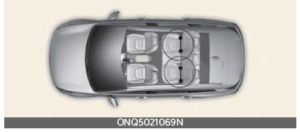
LATCH anchors have been provided in the left and right outboard rear seating positions. Their locations are shown in the illustration. There are no LATCH anchors provided for the center rear seating position.
WARNING
LATCH Lower Anchors
Never attempt to attach a LATCH-equipped seat in the center seating position. LATCH lower anchors are only to be used in the left and right rear outboard seating positions. You may damage the anchors or the anchors may fail and break in a collision if the seat is in the center seating position.
The lower anchor position indicator symbols are located on the left and right rear seatbacks to identify the position of the lower anchors in your vehicle (see arrows in illustration).
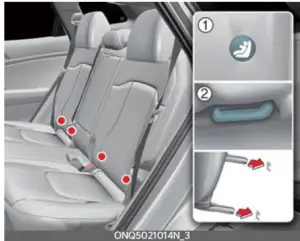
- Lower Anchor position indicator
- Lower Anchor
The LATCH anchors are located between the seatback and the seat cushion of the rear seat left and right outboard seating positions.
To use the lower anchor, push the upper portion of the lower anchor cover.
Securing a child restraint with the LATCH anchors system
To install a LATCH-compatible child restraint in either of the rear outboard seating positions:
- Move the seat belt buckle away from the lower anchors. Otherwise, the webbing or buckle can be damaged by the latch anchor, which can make them become unusable or unsafe.
- Move any other objects away from the anchors that could prevent a secure connection between the child restraint and the lower anchors.
- Place the child restraint on the vehicle seat, then attach the seat to the lower anchors according to the instructions provided by the child restraint manufacturer.
- Follow the child restraint instructions for properly adjusting and tightening the lower attachments on the child restraint to the lower anchors.
WARNING
Take the following precautions when using the LATCH system:
- Read and follow all installation instructions provided with your Child Restraint System.
- To prevent the child from reaching and taking hold of the unused seat belts, buckle all unused rear seat belts before the child is placed into the vehicle. Lock each unused seatbelt following the instructions in the “automatic locking mode” subsection, and place the webbing behind the child seat or against an unused seatback. Children can be strangled if a shoulder belt becomes wrapped around their neck and the seat belt tightens.
- NEVER attach more than one child restraint to a single anchor. This could cause the anchor or attachment to come loose or break.
- Always have the LATCH system inspected by your authorized Kia dealer after an accident. An accident can damage the LATCH system and may not properly secure the child restraint.
NOTICE
The recommended maximum weight for the LATCH system is 65 lbs. (30 kg). When selecting a proper child restraint, consider that the maximum total weight of the child plus the child restraint should be less than 65 lbs. (30 kg).
As a guide, the MAX child restraint weight should be determined by the following calculation:
Child Restraint Weight = 65 – (child’s total weight in lbs.)
Securing a child restraint seat with a “Tether Anchor” system
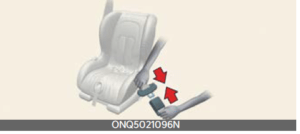
First secure the child restraint with the LATCH lower anchors or the seat belt. If the child restraint manufacturer recom-mends that the top tether strap be attached, attach and tighten the top tether strap to the top tether strap anchor.
Child Restraint hook holders are located on the seat back.
WARNING
Take the following precautions when installing the tether strap:
- Read and follow all installation instructions provided with your Child Restraint System.
- NEVER attach more than one child restraint to a single tether anchor. This could cause the anchor or attachment to come loose or break.
- Do not attach the tether strap to anything other than the correct tether anchor. It may not work properly if attached to something else.
- Do not use the tether anchors for adult seat belts or harnesses, or for attaching other items or equipment to the vehicle.
- Always fasten the seat belts behind the child restraint seat when they are not used to secure the child seat. Failure to do so may result in child strangulation.
To install the tether anchor:
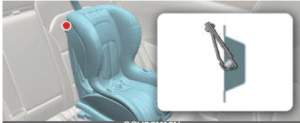
- Route the Child Restraint System seat strap over the seatback.
For vehicles with adjustable headrest, route the tether strap under the headrest and between the headrest posts, otherwise, route the tether strap over the top of the seatback. - Connect the top-tether to the top-tether anchorage, then tighten the top-tether according to the instructions of your Child Restraint System’s manufacturer to firmly attach the Child Restraint System to the seat.
- Check that the child restraint is securely attached to the seat by pushing and pulling the seat forward and from side to side.
Securing a child restraint with a lap/shoulder belt
When not using the LATCH system, all child restraints must be secured to a vehicle rear seat with the lap part of a lap/shoulder belt.
Automatic locking mode
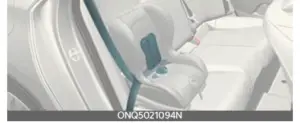
All passenger seat belts move freely under normal conditions and only lock under extreme or emergency conditions (emergency locking mode). So, in order to secure a child restraint, you must manually pull the seat belt all the way out to shift the retractor to the “automatic locking” mode.
The “automatic locking” mode will help prevent the normal movement of the child in the vehicle from causing the seat belt to loosen and compromise the CRS.
To install a CRS on the rear seats, do the following:
- Place the CRS on a rear seat and route the lap/shoulder belt around or through the child restraint, following the restraint manufacturer’s instructions.
Be sure the seat belt webbing is not twisted. - Fasten the lap/shoulder belt latch into the buckle. Listen for the distinct “click” sound.
Position the release button so that it is easy to access in case of an emergency.
- Pull the shoulder portion of the seat belt all the way out. When the shoulder portion of the seat belt is fully extended, it will shift the retractor to the “automatic locking” (child restraint) mode.
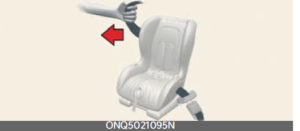
- Slowly allow the shoulder portion of the seat belt to retract and listen for an audible “clicking” or “ratcheting” sound. This indicates that the retractor is in the “automatic locking” mode. If no distinct sound is heard, repeat steps 3 and 4.
- Remove as much slack from the belt as possible by pushing down on the CRS while feeding the shoulder belt back into the retractor.
- Push and pull on the CRS to confirm that the seat belt is holding it firmly in place. If it is not, release the seat belt and repeat steps 2 through 6.
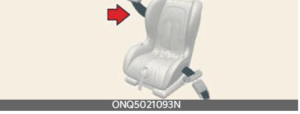
- Double-check that the retractor is in the “automatic locking” mode by attempting to pull more of the seat belt out of the retractor. If you cannot, the retractor is in the “automatic locking” mode.
NOTICE
When the seat belt is allowed to retract to its fully stowed position, the retractor will automatically switch from the “automatic locking” mode to the emergency lock mode for normal adult usage.
WARNING
Auto lock mode
Set the retractor to Automatic Lock mode when installing any Child Restraint System. If the retractor is not in automatic locking mode, the child restraint can move when your vehicle turns or stops suddenly. A child can be seriously injured or killed if the child restraint is not properly anchored in the car.
To remove the child restraint, press the release button on the buckle and then pull the lap/shoulder belt out of the restraint and allow the seat belt to retract fully.
Airbag – advanced Supplemental Restraint System
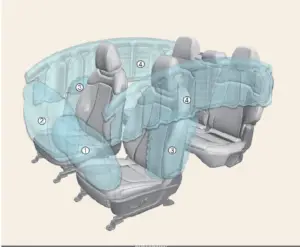
The actual airbags in the vehicle may differ from the illustration.
- Driver’s front air bag
- Passenger’s front airbag
- Side airbag
- Curtain air bag
Even in vehicles with air bags, you and your passengers must always wear the safety belts provided in order to minimize the risk and severity of injury in the event of a collision or rollover.
How does the airbag system operate?
- Air bags are activated (able to inflate if necessary) only when the ENGINE START/STOP button has been turned to the ON position.
- The appropriate airbags inflate instantly in the event of a serious frontal collision or side collision in order to help protect the occupants from serious physical injury.
- There is no single speed at which the airbags will inflate. Generally, air bags are designed to inflate based upon the severity of a collision and its direction, etc. Several factors determine whether the sensors produce an electronic deployment/inflation signal.
- Airbags will not deploy in every crash or collision situation. Air bag deployment depends on a number of factors including vehicle speed, angles of impact, and, the density and stiffness of the vehicles or objects which your vehicle hits in the collision. The determining factors are not limited to those mentioned above.
- The front airbags will completely inflate and deflate in an instant. It is virtually impossible for you to see the airbags inflate during an accident. It is much more likely that you will simply see the deflated airbags hanging out of their storage compartments after the collision.
- In addition to inflating in serious side collisions, side and/or curtain airbags will inflate if the sensing system detects a rollover.
- When a rollover is detected, side and/or curtain airbags will remain inflated longer. This helps provide protection from ejection, especially when used in conjunction with the seat belts.
- In order to help provide protection, the airbags must inflate rapidly. The airbag inflates extremely fast between the occupant and the vehicle struc
- tures before the occupant impacts the vehicle structures. This speed of inflation reduces the risk of serious or life-threatening injuries and is thus a necessary part of the air bag design. However, airbag inflation can also cause injuries which can include facial abrasions, bruises and broken bones. This is because rapid inflation also causes the airbags to expand with a great deal of force.
- There are even circumstances under which contact with the steering wheel or passenger air bag can cause fatal injuries, especially if the occupant is positioned excessively close to the steering wheel or passenger air bag.
WARNING
Airbag inflation
Sit as far back as possible from the steering wheel while still maintaining comfortable control of the vehicle. A distance of at least 10 in (25 cm) from your chest to the steering wheel is recom-mended. Failure to do so can result in airbag inflation injuries to the driver.
Noise and smoke
When inflated, the air bags make a loud noise and leave smoke and powder in the air inside the vehicle. This is normal and is a result of the ignition of the air bag inflator. After the air bag inflates, you may feel substantial discomfort in breathing due to the contact of your chest with both the seat belt and the air bag, as well as from breathing the smoke and powder. Open your doors and/or windows as soon as possible after impact in order to reduce discomfort and prevent prolonged exposure to the smoke and powder.
Though smoke and powder are non-toxic, it may cause irritation to the skin (eyes, nose and throat, etc). If this is the case, wash and rinse with cold water immediately and consult a doctor if the symptom persists.
WARNING
Hot components
Do not touch the air bag storage area’s internal components immediately after airbag inflation. The air bag-related parts in the steering wheel, instrument panel and the roof rails above the front and rear doors are very hot. Hot components can result in burn injuries.
WARNING
Do not install or place any accessories near air bag deployment areas, such as the instrument panel, windows, pillars, and roof rails.
Do not install a child restraint on the front passenger’s seat
Never place a rear-facing child restraint in the front passenger’s seat.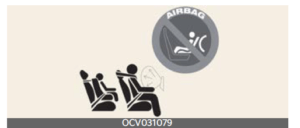
If the air bag deploys, it would impact the rear-facing child restraint, causing serious or fatal injury.
In addition, do not place front-facing child restraints in the front passenger’s seat. If the front passenger air bag inflates, it could cause serious or fatal injuries to the child.
WARNING
Airbag deployment
When children are seated in the rear outboard seats of a vehicle equipped with side and/or curtain air bags, install the Child Restraint System as far away from the door side as possible. Inflation of the side and/or curtain airbags could impact the child.
Airbag warning light
The purpose of air bag warning light in your instrument panel is to alert you of a potential problem with your airbag system, which could include your side and/or curtain airbags used for rollover protection.
If the air bag warning light appears for more than 6 seconds after the ENGINE START/STOP button has been turned to the ON position, or if it appears during vehicle operation, an SRS component may not be functioning properly and you should have your vehicle checked by an authorized Kia dealer.
If any of the following conditions occur, this indicates a malfunction in the air bag system. Have an authorized Kia dealer inspect the airbag system as soon as possible.
- The light does not turn on briefly when you turn the ENGINE START/STOP button to the ON position.
- The light stays on after illuminating for approximately 6 seconds.
- The light comes on while the vehicle is in motion.
- The light blinks when the ENGINE START/STOP button to the ON position.
Supplemental Restraint System (SRS) components and functions

The actual position of SRS components may differ from the illustration.
The SRS consists of the following components:
- Driver’s front airbag module
- Passenger’s front airbag module
- Side airbag modules
- Curtain airbag modules
- Retractor pre-tensioner assemblies
- Airbag warning light
- SRS control module (SRSCM)/ rollover sensor
- Front impact sensors
- Side impact sensors
- Side pressure sensors
- Retractor pre-tensioner assemblies (rear side)
- EFD (Emergency Fastening Device)
- Passenger’s front air bag ON/OFF indicator (Overhead console)
Driver’s front air bag (1)
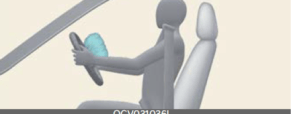
The front air bag modules are located both in the center of the steering wheel and in the front passenger’s panel above the glove box. When the SRSCM detects a sufficiently severe impact to the front of the vehicle, it will automatically deploy the front airbags.
Driver’s front air bag (2)
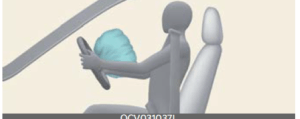
Upon deployment, tear seams molded directly into the pad covers will separate under pressure from the expansion of the air bags. Further opening of the covers then allows full inflation of the air bags.
Driver’s front air bag (3)
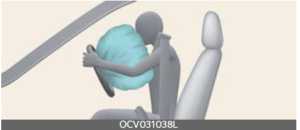 A fully inflated airbag (with a properly fastened seat belt) slows the forward motion of the driver or passenger, reducing the risk of head and chest injury.
A fully inflated airbag (with a properly fastened seat belt) slows the forward motion of the driver or passenger, reducing the risk of head and chest injury.
After complete inflation, the air bag immediately starts deflating, enabling the driver to maintain forward visibility and the ability to steer or operate other controls.
Passenger’s front air bag
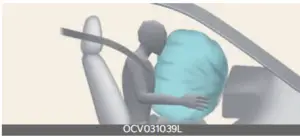
WARNING
Air bag obstructions
Do not install or place any accessories on the steering wheel, instrument panel, or on the front passenger’s panel above the glove box in a vehicle. Such objects may become dangerous projectiles if the air bag deploys.
WARNING
Flying objects
Do not place any objects (an umbrella, bag, etc.) between the front door and the front seat. Such objects may become dangerous projectiles if the side airbag inflates.
- If an air bag deploys, there may be a loud noise followed by a fine dust released in the vehicle. These conditions are normal and are not hazardous – the airbags are packed in this fine powder. The dust generated during air bag deployment may cause skin or eye irritation as well as aggravate asthma for some persons. Always wash all exposed skin areas thoroughly with cold water and mild soap after an accident in which the airbags were deployed.
- skin or eye irritation as well as aggravate asthma for some persons. Always wash all exposed skin areas thoroughly with cold water and mild soap after an accident in which the air bags were deployed.
- The SRS can function only when the ENGINE START/STOP button is in the ON position. The SRS is not working properly if any of the following situations occur:
- the SRS airbag warning light does not appear the SRS airbag warning light remains on continuously after illuminating for about 6 seconds when the ENGINE START/STOP button is turned to the ON position or after the vehicle is in ready mode
- the SRS airbag warning light comes on while driving
If this occurs, have your vehicle immediately inspected by an authorized Kia dealer.
NOTICE
Before you replace a fuse or disconnect a battery terminal, change the ENGINE START/STOP button to the OFF position. Never remove or replace the air bag related fuse(s) when the ENGINE START/STOP button is ON position. Failure to heed this warning will cause the SRS air bag warning light to appear.
Occupant Detection System(ODS)
Your vehicle is equipped with an Occu-pant Detection System (ODS) in the front passenger’s seat.
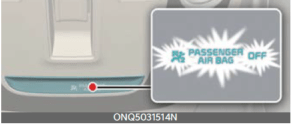
The ODS is designed to detect the presence of a properly-seated front passenger and determine if the passenger’s front air bag should be enabled (may inflate) or not. Only the front passenger front air bag is controlled by the ODS.
Do not put anything in front of the passenger air bag ” ” indicator.
Main components of the ODS
- A detection device is located within the front passenger seat cushion.
- An electronic system determines whether the passenger air bag systems should be activated or deactivated.
- An indicator light located on the overhead console which appears the words PASSENGER AIR BAG ” indicates the front passenger air bag system is deactivated.
- The overhead console air bag warning light is interconnected with the ODS.
If the front passenger seat is occupied by a person that the system determines to be of appropriate size, and he/she sits properly (sitting upright with the seat-back in an upright position, centered on the seat cushion with their seat belt on, legs comfortably extended and their feet on the floor), the PASSENGER AIR BAG - ” indicator will turn off and the front passenger’s air bag will be able to inflate, if necessary, in frontal crashes.
You will find the PASSENGER AIR BAG ” indicator on the overhead console.
This system detects condition 1~4 in the following table and activates or deactivates the front passenger air bag based on these conditions.
Always be sure that you and all vehicle occupants are seated and restrained properly (sitting upright with the seat in an upright position, centred on the seat cushion, with the person’s legs comfort-ably extended, feet on the floor, and wearing the safety belt properly) for the most effective protection by the air bag and the safety belt.
The ODS may not function properly if the passenger takes actions which can defeat the detection system. These include:
- Failing to sit in an upright position.
- Leaning against the door or center console.
- Sitting towards the sides or the front of the seat.
- Putting legs on the dashboard or resting them on other locations reduce the passenger weight on the front seat.
- Improperly wearing the safety bel
- Reclining the seatback.
Conditions and operation of the front passenger ODS
|
Condition detected by the occupant classification system |
Indicator/Warning light | Devices | |
| “PASSENGER AIR BAG
OFF” indicator light |
SRS warning light | Front passenger air bag | |
| 1. Adult*1 | Off | Off | Activated |
| 2. Child Restraint System (CRS) with child under
12 months old*2*3*4 |
On | Off | Deactivated |
| 3. Unoccupied | On | Off | Deactivated |
| 4. Malfunction in the system | Off | On | Activated |
- The system judges a person of adult size as an adult. When a smaller adult sits in the front passenger
seat, the system may recognize him/her as a child depending on his/her physique and posture. - Do not allow children to ride in the front passenger seat. When a larger child who has outgrown a CRS sits in the front passenger seat, the system may recognize him/her as an adult depending upon his/her physique or sitting position.
- Never install a CRS on the front passenger seat.
- The PASSENGER AIR BAG ” ” indicator may turn on or off when a child above 12 months to 12 years old (with or without a CRS) sits in the front passenger seat. This is a normal condition.
WARNING
- Do not install a child restraint seat in the passenger seat when the seat is heavily soaked with any type of liquid.
- Do not alter or remodel the Occupant Detection System (ODS). This may damage the system and prevent its proper function in a collision.
NOTICE
- Do not use car seat cushions that cover up the surface of the seat and aftermarket manufactured passenger seat heaters.
- After conducting car interior cleaning using steam or detergent, the seat should be dried properly. Afterwards, check for normal operation of the PASSENGER AIR BAG “OFF” and air bag warning lights.
- Any service related to the passenger seat and the ODS must be done at an authorized Kia dealership.
- After the passenger seat has been removed or installed for repair purposes, check for normal operation of the PASSENGER AIR BAG ” ” and airbag warning lights with a person seated or not seated in the passenger seat.
WARNING
When the PASSENGER AIR BAG ” “
the symbol appears the passenger air bag system will not operate. The passenger airbag system will operate when necessary if the symbol does not appear.
NOTICE
Do not modify or replace the front passenger seat. Don’t place anything on or attach anything such as a blanket, front seat cover or aftermarket seat heater to the front passenger seat. This can adversely affect the Occupant Detection System.
WARNING
ODS System
Riding in an improper position adversely affects the Occupant Detection System and may result in the deactivation of the front passenger airbag. It is important for the driver to instruct the passenger as to the proper seating instructions as contained in this manual.
- Do not place a heavy load in the front passenger seatback pocket or on the front passenger seat.
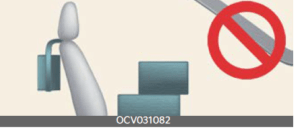
- Do not place feet on the front passenger seatback.
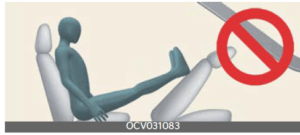
- Do not move your hips too forward in the seat.
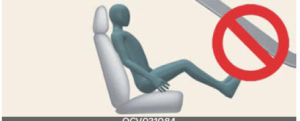
- Never excessively recline the front passenger seatback.
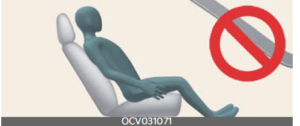
- Never place feet on the dashboard.
- Never lean on the door or center console.
- Do not sit with your weight excessively skewing to the left or right on the front passenger seat.

- Do not use car seat accessories, such as thick blankets and cushions, that
cover up the car seat surface. - Do not sit on the passenger seat wearing heavily padded clothes, such as ski wear and hip protector.
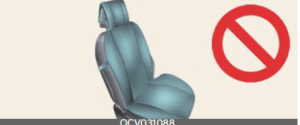
- Do not place electronic devices, such as laptops and DVD player, or conductive materials such, as water bottles, on the passenger seat.
- Do not use electronic devices, such as laptops and satellite radios, that use inverter chargers.
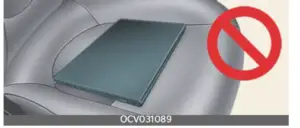
- Wet Passenger Seat
Do not spill liquid in the passenger seat. Spilled liquid on the passenger seat may cause the air bag warning light to appear or malfunction. If any liquid is spilled, make sure the seat has been completely dried before driving the vehicle.
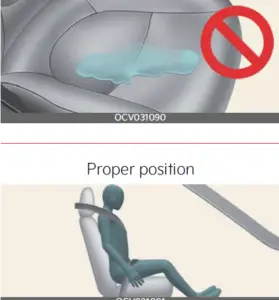
When an adult is seated in the front passenger seat, if the PASSENGER AIR BAG
” indicator is on, change the ENGINE START/STOP button to the OFF position and ask the passenger to sit properly
(sitting upright with the seatback in an upright position centred on the seat cushion with their seat belt on, legs comfortably extended and their feet on the floor). Restart the vehicle and have the person remain in that position. This will allow the system to detect the person and to enable the passenger air bag.
If the PASSENGER AIR BAG “” indicator is still on, ask the passenger to move to the rear seat.
WARNING
PASSENGER AIR BAG ” ” light
Do not allow an adult passenger to ride in the front seat when the PASSENGER
AIR BAG “” indicator appears because the air bag will not deploy in the event of a crash. The driver must instruct the passenger to reposition himself in the seat. Failure to properly position yourself may lead to air bag deactivation resulting in air bag non-deployment in a collision. If the PASSEN-
GER AIR BAG ” ” indicator remains
appeared after the passenger repositions themselves properly and the car is restarted, it is recommended that the passenger move to the rear seat because the passenger’s front air bag will not deploy.
NOTICE
The PASSENGER AIR BAG “” indicator appears for about 4 seconds after the ENGINE START/STOP button is turned to the ON position after the vehicle is started. If the front passenger seat is occupied, the occupant detection sensor will then classify the front passenger after several more seconds.
- Even though your vehicle is equipped with the Occupant Detection System, never install a Child Restraint System in the front passenger’s seat. A deploying air bag can forcefully strike a child resulting in serious injuries or death.
Any child age 13 and under should ride in the rear seat. Children too large for child restraints should use the available lap/shoulder belts. No matter what type of crash, children of all ages are safer when restrained in the rear seat.
If the ODS is not working properly, the Supplemental Restraint System (SRS) air bag warning light on the instrument panel will appear because the passenger’s front air bag is connected with the ODS. If there is a malfunction of the ODS the PASSENGER AIRBAG ” ” indicator
will not appear. In this case, the passenger’s front airbag will inflate in frontal impact crashes even if there is no occupant in the front passenger seat.
Driver’s and passenger’s front airbag
Your vehicle is equipped with an advanced supplemental restraint (air bag) system and lap/shoulder belts at both the driver and passenger seating position.
Driver’s front air bag
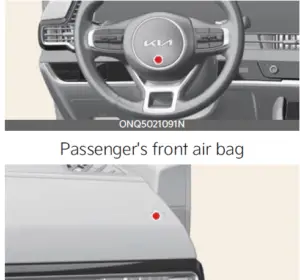
The indication of the system’s presence are the letters “AIR BAG” located on the air bag pad cover on the steering wheel and the passenger’s side front panel pad above the glove box.
The Supplemental Restraint System
(SRS) consists of air bags installed under the pad covers in the center of the steering wheel and the passenger’s side front panel above the glove box.
The purpose of the SRS is to provide the vehicle’s driver and/or the front passenger with additional protection than that offered by the seat belt system alone in case of a frontal impact of sufficient severity. The SRS uses sensors to gather information about the driver’s and front passenger’s seat belt usage and impact severity.
The seat belt buckle sensor determines if the front passenger’s seat belt is fastened.
These sensors provide the ability to control the SRS deployment based on whether or not the seat belts are fastened, and how severe the impact is.
The advanced SRS offers the ability to control the airbag inflation with two levels. A first stage level is provided for moderate-severity impacts. A second stage level is provided for more severe impacts.
According to the impact severity and seat belt usage, the SRS Control Module (SRSCM) controls the air bag inflation. Failure to properly wear seat belts can increase the risk or severity of injury in an accident.
Additionally, your vehicle is equipped with an Occupant Detection System
(ODS) in the front passenger’s seat. The ODS detects the presence of a passenger in the front passenger’s seat and will turn off the front passenger’s air bag under certain conditions.
WARNING
Modification to the seat structure can cause the airbag to deploy at a different level than should be provided.
Manufacturers are required by government regulations to provide a contact point concerning modifications to the vehicle for persons with disabilities, which modifications may affect the vehicle’s advanced air bag system. That contact is Kia’s toll-free Customer Assistance center at 1-800-333-4Kia.
However, Kia does not endorse nor will it support any changes to any part or structure of the vehicle that could affect the advanced air bag system, including the ODS.
WARNING
Replacement/modifications
The front passenger seat, dashboard or door should not be replaced except by an authorized Kia dealer using original Kia parts designed for this vehicle and model. Any other such replacement or modification could adversely affect the operation of the Occupant Detection System and your advanced air bags.
Advanced air bags are combined with pre-tensioner seat belts to help provide enhanced occupant protection in frontal crashes. Front air bags are not intended to deploy in collisions in which sufficient protection can be provided by the seat belt.
NOTICE
Air bags can only be used once – have an authorized Kia dealer replace the air bag immediately after deployment.
Front air bags are not intended to deploy in side-impact, rear-impact or rollover crashes. However, when frontal deployment threshold is satisfied at side-impact, front air bags may deploy. In addition, front air bags will not deploy in frontal crashes below the deployment threshold.
WARNING
SRS Wiring
Do not tamper with or disconnect SRS wiring or other components of the SRS system. Doing so could result in injury, due to accidental deployment of the air bags or by rendering the SRS inoperative.
WARNING
No attaching objects
No objects (such as crash pad cover, cellular phone holder, cup holder, perfume or stickers) should be placed over or near the airbag modules on the steering wheel, instrument panel, windshield glass, and the front passenger’s panel above the glove box. Such objects could cause harm if the vehicle is in a crash severe enough to cause the airbags to deploy.
Do not place any objects over the air bag or between the air bag and yourself.
Additionally, never place or insert any object into any small opening near side airbag labels attached to the vehicle seats.
When the air bag deploys, the object may affect the deployment and result in an unexpected accident or bodily harm.
Side airbag
Your vehicle is equipped with a side air bag in each front seat.

The actual airbags in the vehicle may differ from the illustration.
The purpose of the airbag is to provide the vehicle’s driver and/or the front passenger with additional protection than that offered by the seat belt alone.
- The side airbags are designed to deploy during certain side-impact collisions, depending on the crash severity of impact.
- The side air bags may deploy on the side of the impact or on both sides.
- The side and/or curtain airbags on both sides of the vehicle will deploy if a rollover or possible rollover is detected.
- The side air bags are not designed to deploy in all side impact or rollover situations.
WARNING
Unexpected deployment
Avoid impact to the side impact airbag sensor when the ENGINE START/STOP button is ON to prevent unexpected deployment of the side air bag.
- The side air bag is supplemental to the driver’s and the passenger’s seat belt systems and is not a substitute for them. Therefore your seat belts must be worn at all times while the vehicle is in operation.
- For best protection from the side air bag system and to avoid being injured by the deploying side air bag, both front seat occupants should sit in an upright position with the seat belt properly fastened. The driver’s hands should be placed on the steering wheel at the 9:00 and 3:00 positions. The passenger’s arms and hands should be placed on their laps.
WARNING
Deployment
Do not install any accessories including seat covers, on the side or near the side air bag as this may affect the deploy-ment of the side airbags.
- If the seat or seat cover is damaged, have the vehicle checked and repaired by an authorized Kia dealer. Inform the dealer that your vehicle is equipped with side airbags and an Occupant Detection System (ODS).
WARNING
Flying objects
Do not place any objects (an umbrella, bag, etc.) between the front door and the front seat. Such objects may become dangerous projectiles if the side airbag inflates.
WARNING
No attaching objects
- Do not place any objects over the air bag or between the airbag and yourself. Also, do not attach any objects around the area the air bag inflates such as the door, side door glass, front and rear pillar.
- Do not put any objects between the side airbag label and the seat cushion. It could cause harm if the vehicle is in a crash severe enough to cause the airbags to deploy.
- Never place or insert any object into any small opening near side airbag labels attached to the vehicle seats. When the air bag deploys, the object may affect the deployment and result in an unexpected accident or bodily harm.
- Do not install any accessories on the side or near the side airbags.
Curtain air bag
Curtain air bags are located along both sides of the roof rails above the front and rear doors.

The actual airbags in the vehicle may differ from the illustration.
They are designed to help protect occupants in certain side impacts and to help prevent them from ejecting out of the vehicle as a result of a rollover, especially when the seatbelts are also in use.
- The curtain airbags are designed to deploy during certain side-impact collisions, depending on the severity of impact. However, when side deploy-ment threshold is satisfied at front impact, side airbags may deploy.
- The curtain air bags may deploy on the side of the impact or on both
sides. - Also, the curtain airbags on both sides of the vehicle will deploy in certain rollover situations.
- The curtain air bags are not designed to deploy in all side impact or rollover situations.
Do not allow the passengers to lean their heads or bodies against the doors, put their arms on the doors, stretch their arms out of the window or place objects between the doors and passengers when they are seated on seats equipped with side impact and/or curtain air bags.
NOTICE
Never try to open or repair any components of the side and curtain airbag system. This should only be done by an authorized Kia dealer.
WARNING
No attaching objects
- Do not place any objects over the air bag. Also, do not attach any objects around the area the air bag inflates such as the door, side door glass, front and rear pillar, roof side rail.
- Do not hang hard, breakable, or heavy objects on the coat hooks for safety reasons.
Airbag collision sensors
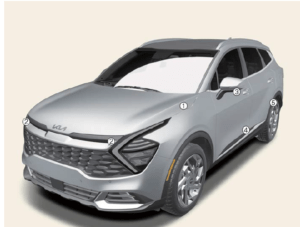

The actual shape and position of sensors may differ from the illustration.
- Supplemental Restraint System (SRS) control module/rollover sensor
- Front impact sensors
- Side pressure sensors (front door)
- Side impact sensors (B-pillar)
- Side impact sensors (C-pillar)
WARNING
Air bag sensors
- Do not hit or allow any objects to impact the locations where air bags or sensors are installed.
This may cause unexpected air bag deployment, which could result in serious personal injury or death. - If the installation location or angle of the sensors is altered in any way, the air bags may deploy when they should not or they may not deploy when they should.
Therefore, do not try to perform maintenance on or around the airbag sensors. Have the vehicle checked and repaired by an authorized Kia dealer. - Do not arbitrarily touch the front impact sensors. When the angle of the sensor is changed, the air bag system may malfunction.
Problems may arise if the sensor installation angles are changed due to the deformation of the front bumper, front end module, body or front doors where side collision sensors are installed. Have the vehicle checked and repaired by an authorized Kia dealer.
Installing bumper guards (or side step or running board) or replacing a bumper (or front door module) with non-genuine parts may adversely affect your vehicle’s collision and air bag deployment performance.
Why didn’t my airbag go off in a collision? (Inflation and non-inflation conditions of the air bag)
There are many types of accidents in which the air bag would not be expected to provide additional protection.
These include rear impacts, second or third collisions in multiple-impact accidents, as well as low-speed impacts.
Airbag inflation conditions
Front air bags

Front air bags are designed to inflate in a frontal collision depending on several factors, including the severity of impact of the front collision.
Side and curtain airbags
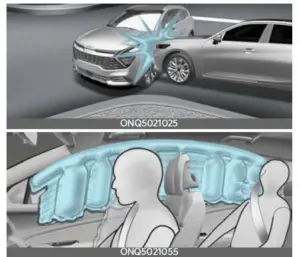
The actual air bags in the vehicle may differ from the illustration.
Side and/or curtain air bags are designed to inflate when an impact is detected by side collision sensors depending on several factors, including the severity of impact resulting from a side impact collision.
Also, the side and curtain air bags are designed to inflate when a rollover is detected by a rollover sensor.
Although the front air bags (driver’s and front passenger’s airbags) are primarily designed to inflate in frontal collisions, they may inflate in other types of collisions if the front impact sensors detect a sufficient frontal force in another type of impact.
Similarly, although side and curtain airbags are designed to inflate in certain side-impact collisions, they may inflate in other types of collisions where a side force is detected by the sensors. For instance, side air bag and/or curtain airbags may inflate if rollover sensors indicate the possibility of a rollover occurring (even if none actually occurs) or in other situations, including when the vehicle is tilted while being towed.
Even if side and/or curtain airbags do not provide impact protection in a roll-over, they will deploy to prevent the ejection of occupants, especially those who are restrained with seat belts.
If the vehicle chassis is impacted by bumps or objects on unimproved roads, the airbags may deploy. Drive carefully on unimproved roads or on surfaces not designed for vehicle traffic to prevent unintended air bag deployment.
Air bag non-inflation conditions
- Airbags may not deploy in certain low-speed collisions where the air bag would not add any benefit beyond the protection already offered by the seat belts.
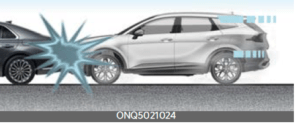
- Front airbags are not designed to inflate in rear collisions, because occupants are moved backwards by the force of the impact. In this case, inflated airbags would not be able to provide any additional benefit.

- Front airbags may not inflate in side impact collisions, because passengers move in the direction of the collision. Thus, in side impacts, frontal airbag deployment would not provide additional occupant protection.

- In an angled collision, the force of impact may direct the occupants in a direction where the air bags would not be able to provide any additional benefit, and thus the sensors may not deploy any air bags.

- Just before impact, drivers often brake heavily. Such heavy braking lowers the front portion of the vehicle causing it to “ride” under a vehicle with a higher ground clearance. Air bags may not inflate in this “under-ride” situation because deceleration forces that are detected by sensors may be significantly reduced by such “under-ride” collisions.
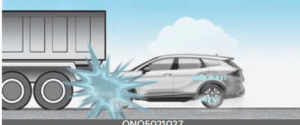
- Front air bags may not inflate in all rollover accidents when the SRS Control Module (SRSCM) indicates that the front air bag deployment would not provide additional occupant protection.

- Airbags may not inflate if the vehicle and the full force of the impact is not delivered to the sensors.
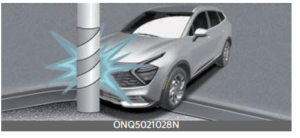
Supplemental Restraint System (SRS) care
The Supplemental Restraint System
(SRS) is virtually maintenance-free and so there are no parts you can safely service by yourself.
If the SRS air bag warning light does not appear, or continuously remains on, have your vehicle immediately inspected by an authorized Kia dealer?
Any work on the SRS, such as removing, installing, repairing, or any work on the steering wheel, the front passenger’s panel, front seats and roof rails must be performed by an authorized Kia dealer. Improper handling of the SRS may result in serious personal injury.
For cleaning the air bag pad covers, use only a soft, dry cloth or one which has been moistened with plain water. Solvents or cleaners could adversely affect the air bag covers and proper deployment of the system.
If components of the airbag system must be discarded, or if the vehicle must be scrapped, certain safety precautions must be observed. An authorized Kia dealer knows these precautions and can give you the necessary information. Failure to follow these precautions and procedures could increase the risk of bodily injury.
WARNING
Tampering with SRS
Do not tamper with or disconnect SRS wiring or other components of the SRS system. Doing so could result in the accidental inflation of the airbag or render the SRS inoperative.
WARNING
Towing vehicle
Always have the ignition off and wait for 3 minutes when your vehicle is being towed. The side airbags may inflate if the vehicle is tilted such as when being towed because of the rollover sensors in the vehicle.
Additional safety precautions
- Never let passengers ride in the cargo area or on top of a folded-down back seat. All occupants should sit upright, fully back in their seats with their seat belts on and their feet on the floor.
- Passengers should not move out of or change seats while the vehicle is moving. A passenger who is not wearing a seat belt during a crash or emergency stop can be thrown against the inside of the vehicle, against other occupants, or out of the vehicle.
- Each seat belt is designed to restrain one occupant. If more than one person uses the same seat belt, they could be seriously injured or killed in a collision.
- Do not use any accessories on seat belts. Devices claiming to improve occupant comfort or reposition the seat belt can reduce the protection provided by the seat belt and increase the chance of serious injury in a crash.
- Passengers should not place hard or sharp objects between themselves and the airbags. Carrying hard or sharp objects on your lap or in your mouth can result in injuries if an air bag inflates.
- Keep occupants away from the airbag covers. All occupants should sit upright, fully back in their seats with their seat belts on and their feet on the floor. If occupants are too close to the air bag covers, they could be injured if the air bags inflate.
- Do not attach or place objects on or near the air bag covers. Any object attached to or placed on the front or side air bag covers could interfere with the proper operation of the air bags.
- Do not modify the front seats. Modification of the front seats could interfere with the operation of the supplemental restraint system sensing components or side air bags.
- Do not place items under the front seats. Placing items under the front seats could interfere with the operation of the supplemental restraint system sensing components and wiring harnesses.
- Never hold an infant or child on your lap. The infant or child could be seriously injured or killed in the event of a crash. All infants and children should be properly restrained in appropriate child safety seats or seat belts in the rear seat.
WARNING
- Sitting improperly or out of position can cause occupants to be shifted too close to a deploying air bag, strike the interior structure or be thrown from the vehicle resulting in serious injury or death.
- Always sit upright with the seatback in an upright position, centered on the seat cushion with your seat belt on, legs comfortably extended and your feet on the floor.
Adding equipment to or modifying your air bag-equipped vehicle
If you modify your vehicle by changing your vehicle’s frame, bumper system, front end or side sheet metal or ride height, this may affect the operation of your vehicle’s air bag system.
Airbag warning labels
Air bag warning labels, some required by the U.S. National Highway Traffic Safety Administration (NHTSA), are attached to the sun visor to alert the driver and passengers of potential risks of the air bag system.
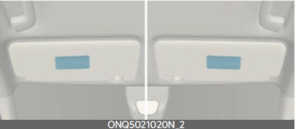
FAQ
A: A child restraint system is a safety device designed to protect infants and children during car travel. It’s essential in the Sportage to ensure the safety of young passengers in compliance with safety regulations.
A: The 2023 Sportage typically accommodates various child restraint systems, including rear-facing infant seats, forward-facing child seats, and booster seats, depending on the child’s age, weight, and height.
A: Yes, the Sportage often comes equipped with the LATCH (Lower Anchors and Tethers for Children) system, providing designated anchor points for securing child restraint systems.
A: Follow the manufacturer’s instructions for the specific child seat you’re using and refer to the Sportage’s owner’s manual for guidance on using the LATCH system or seat belts for installation.
A: The transition from a rear-facing to a forward-facing car seat should occur based on the child’s size and the specific seat’s weight and height limits. Refer to the child seat manufacturer’s guidelines.
A: The Sportage’s airbag system is designed to deploy rapidly upon impact in the event of a collision, providing a cushioning effect to protect occupants from severe injury.
A: The 2023 Sportage typically comes equipped with front airbags, side airbags for the front seats, and curtain airbags that deploy from the ceiling to protect passengers in both the front and rear seats during side impacts.
A: Yes, many vehicles, including the Sportage, often have the option to deactivate the front passenger airbag using a switch or key to accommodate rear-facing child seats in the front passenger seat.
A: Placing a rear-facing child seat in the front passenger seat with the airbag deactivated is generally considered safe, but it’s advisable to follow the child seat manufacturer’s guidelines and ensure the seat is properly secured.
A: Proper seat positioning, keeping hands on the steering wheel, and sitting back in the seat with a safe distance from the airbag are important precautions to minimize injury in the event of airbag deployment.
A: Airbags are designed to deploy in response to significant impacts or collisions. They should not deploy during routine driving or minor incidents.
A: The airbag system typically requires minimal maintenance. However, it’s essential to have any airbag warning lights or system malfunctions inspected and repaired by a qualified technician promptly.
A: Pregnant passengers should sit as far back as possible from the airbag and consult with a healthcare professional for specific safety recommendations during pregnancy.
A: The airbag system should not be intentionally disabled except when deactivating the front passenger airbag to accommodate a rear-facing child seat. It’s not advisable to disable airbags for other reasons.
A: Yes, the owner’s manual typically contains detailed information and guidelines on properly using child restraint systems and understanding the airbag restraint system in the 2023 Sportage.
Useful Link
View Full User Guide: Kia Sportage 2023 User Guide
Download Manuals: https://owners.kia.com/content/owners/en/manuals.html
2023 KIA SPORTAGE Specs, Price, Features and Mileage (Brochure)

